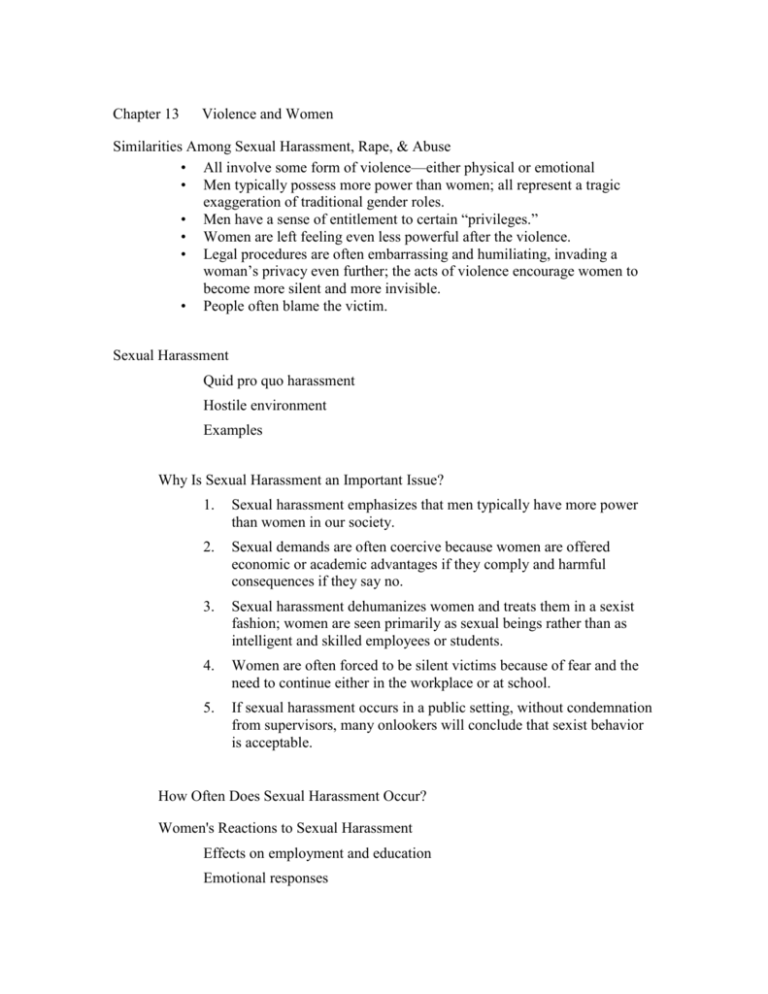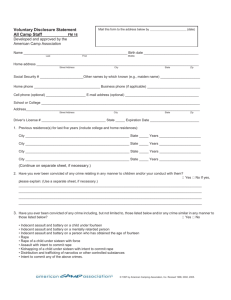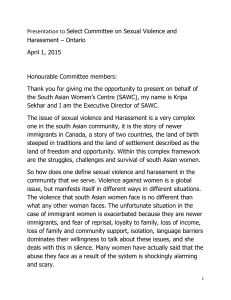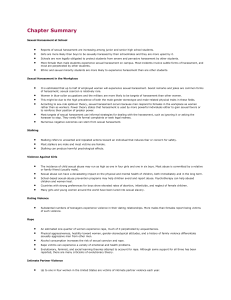
Chapter 13
Violence and Women
Similarities Among Sexual Harassment, Rape, & Abuse
• All involve some form of violence—either physical or emotional
• Men typically possess more power than women; all represent a tragic
exaggeration of traditional gender roles.
• Men have a sense of entitlement to certain “privileges.”
• Women are left feeling even less powerful after the violence.
• Legal procedures are often embarrassing and humiliating, invading a
woman’s privacy even further; the acts of violence encourage women to
become more silent and more invisible.
• People often blame the victim.
Sexual Harassment
Quid pro quo harassment
Hostile environment
Examples
Why Is Sexual Harassment an Important Issue?
1.
Sexual harassment emphasizes that men typically have more power
than women in our society.
2.
Sexual demands are often coercive because women are offered
economic or academic advantages if they comply and harmful
consequences if they say no.
3.
Sexual harassment dehumanizes women and treats them in a sexist
fashion; women are seen primarily as sexual beings rather than as
intelligent and skilled employees or students.
4.
Women are often forced to be silent victims because of fear and the
need to continue either in the workplace or at school.
5.
If sexual harassment occurs in a public setting, without condemnation
from supervisors, many onlookers will conclude that sexist behavior
is acceptable.
How Often Does Sexual Harassment Occur?
Women's Reactions to Sexual Harassment
Effects on employment and education
Emotional responses
Attitudes About Sexual Harassment
Gender
Characteristics of the situation
What To Do About Sexual Harassment
Individual Action
How Men Can Help
Avoid behaviors that might be perceived as sexual harassment
Speak up when you see sexual harassment
Society's Response to the Harassment Problem
Institutional commitment to change
Develop clear policies about sexual harassment; publicize the policies;
hold workshops
Work to change public opinion; information and awareness
Change the uneven distribution of power that encourages sexual
harassment
Rape
Sexual assault
Acquaintance rape more frequent than stranger rape
Marital rape
Rape as a weapon of war
How Often Does Rape Occur?
Frequency: in US, woman is raped every 2 minutes.
1 in 4: during her lifetime. Especially high in college age women
Acquaintance Rape
50% to 55% of women will experience some form of sexual assault
from an acquaintance
Role of alcohol
Rohypnol and other "date rape drugs"
Settings
Miscommunication
Fear of Rape
Women’s Reactions to Rape
Short-Term Adjustment
Long-Term Adjustment
Posttraumatic Stress Disorder (PTSD)
Threat of rape causes many women to feel unsafe, and restrict their activities.
Attitudes About Rape
Blaming the Victim
Gender roles
Characteristcs of sexually aggressive men
Conservatism
Gender
Circumstances surrounding the assault
Myths About Rape
Myth 1:
Rapists are strangers—that is, people unknown to the victim.
Myth 2:
Women ask to be raped; they could avoid rape if they wanted to.
Myth 3:
Women lie about being raped.
Myth 4:
Pornography has no effect on men’s likelihood to rape.
Myth 5: Only deviant men would consider raping a woman.
Victim characteristics
Alcohol consumption
Rape Prevention
Individuals' Prevention of Rape by Strangers
Individuals' Prevention of Acquaintance Rape
Society's Prevention of Rape
1.
Professionals who work with children need to be alert for evidence of
child sexual abuse; in many states, people who work with children are
required to complete relevant training programs.
2.
Hospitals and medical providers should be sensitive to the emotional
and physical needs of girls and women who have been raped.
3.
Rape victims should be encouraged to report rape. Anonymous
telephone counseling services and legal assistance should be easily
available and widely publicized.
4.
Laws must be reformed so that the legal process is less stressful and
more supportive for the victims.
5.
Education about rape needs to be improved, beginning in junior high
or high school. Rape-prevention programs must emphasize that men
can control their sexual impulses and that women are not to be
blamed for rape.
6.
Men’s groups must become more involved in rape prevention.
7.
Violence must be less glorified in the media.
8.
Ultimately, our society must direct more attention toward the needs of
women.
The Abuse of Women
How Often Does the Abuse of Women Occur?
The Dynamics of Abuse
Abuse cycle
Tension building phase
Acute battering phase
Loving phase
Women’s Reactions to Abuse
Emotional Reactions
Physical Problems
Characteristics Associated With Abusive Relationships
Family Variables Associated with Abuse
Personal Characteristics of Male Abusers
Antisocial personality disorder
Attitudes About the Abuse of Women
Myths About the Abuse of Women
Myth 1:
Abuse is rare.
Myth 2:
Men experience as much abuse as women.
Myth 3:
Abuse is limited to the lower social classes.
Myth 4:
Abuse is much more common among ethnic minority groups than among
European Americans.
Myth 5:
Abused women deserve to be beaten and humiliated.
Myth 6:
Abused women could easily leave, if they really wanted to.
How Abused Women Take Action
Therapy
Deciding to Leave a Relationship
Shelters for Battered Women
Society’s Response to the Problem of Abuse
Government policies should be consistent with addressing the problem
Police training must be improved
Community organizations should take on the problem of abuse
Medical organizations should continue their progress in increasing awareness of the
issue of abuse of women
World-wide awareness needs to increase







